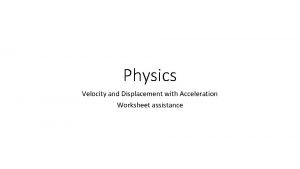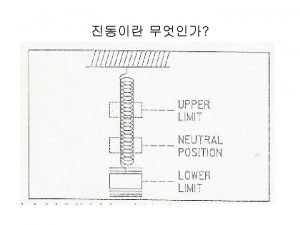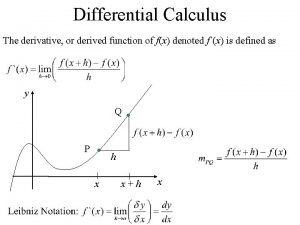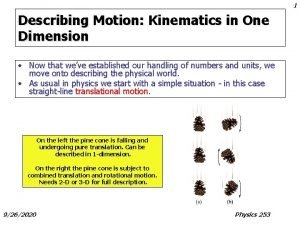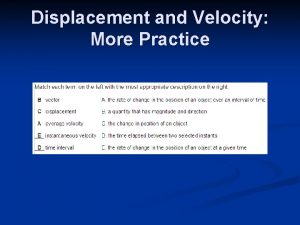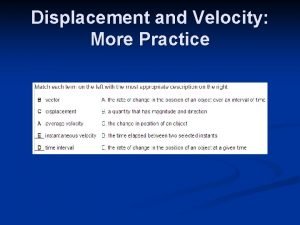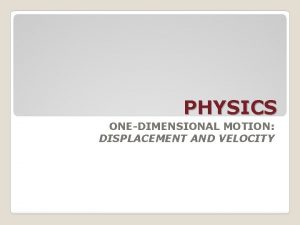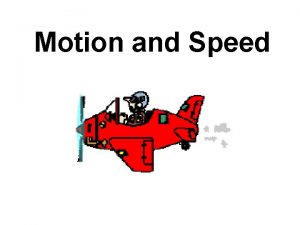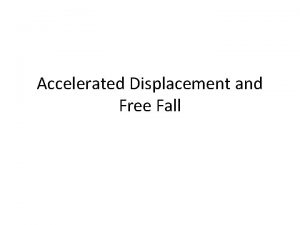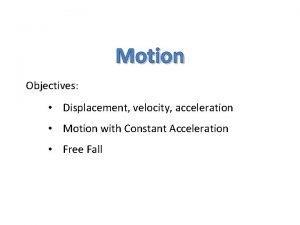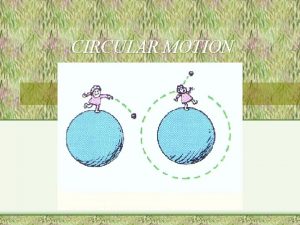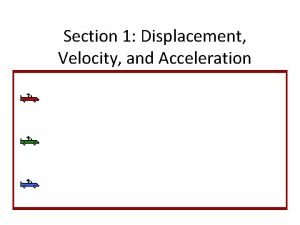METHODS OF MOTION Displacement and Velocity AP Physics










- Slides: 10

METHODS OF MOTION -Displacement and Velocity AP Physics B

SI units for Physics The SI stands for "System International”. There are three fundamental SI units for LENGTH, MASS, and TIME. They basically breakdown like this: SI Quantity SI Unit Length Meter Mass Kilogram Time Second Of course there are many other units to consider. Many times, however, we express these units with prefixes attached to the front. This will, of course, make the number either larger or smaller. The nice thing about the prefix is that you can write a couple of numbers down and have the unit signify something larger.

Kinematics – Key Variables Symbol Variable Units t Time s d Distance m x or y Position m vo Initial velocity m/s v Final velocity m/s

Reference Frame A direct force leads to motion You are standing on the side of the road and watch a car with people go by. ◦ The car and people are traveling at the same speed. Inertial A fictional force leads to motion ◦ Newton’s Law of Inertia You are driving in a car with other people. ◦ People are not moving with respect to the inside of the car. An outside observer may say otherwise. Non-inertial

Displacement � � Displacement (x or y) "Change in position" It is not necessarily the total distance traveled. In fact, displacement and distance are entirely different concepts. Displacement is relative to an axis. ◦ "x" displacement means you are moving horizontally either right or left. ◦ "y" displacement means you are moving vertically either up or down. ◦ The word change is expressed using the Greek letter DELTA ( Δ ). ◦ To find the change you ALWAYS subtract your FINAL - INITIAL position ◦ It is therefore expressed as either Δx = x - xo or Δy = y – yo Distance - How far you travel regardless of direction.

Example � Suppose a person moves in a straight line from the lockers (at a position of x = 1. 0 m) toward the physics lab (at a position x = 9. 0 m), as shown below. The answer is positive so the person must have been traveling horizontally to the right.

Example Suppose the person turns around! The answer is negative so the person must have been traveling horizontally to the left. What is the DISPLACEMENT for the entire trip? What is the total DISTANCE for the entire trip?

Average Velocity � � Velocity is defined as: “The RATE at which DISPLACEMENT changes”. Rate = ANY quantity divided by TIME. Average SPEED is simply the “RATE at which DISTANCE changes”.

Example � A quarterback throws a pass to a defender on the other team who intercepts the football. Assume the defender had to run 50 m away from the quarterback to catch the ball, then 15 m towards the quarterback before he is tackled. The entire play took 8 seconds. Let's look at the defender's average velocity: Let's look at the defender's speed: “m/s” is the derived unit for both speed and velocity.

Instantaneous Velocity Instantaneous velocity is a measure of an object’s displacement per unit time at a particular point in time. On an x v. t graph, slope of a line at a The term velocity alone given point is the means instantaneous velocity. All motion is translational?
 Single displacement vs double displacement
Single displacement vs double displacement Displacement and velocity worksheet
Displacement and velocity worksheet Vibration displacement velocity acceleration
Vibration displacement velocity acceleration Differential calculus
Differential calculus Angular quantities
Angular quantities Initial velocity and final velocity formula
Initial velocity and final velocity formula Speed unit
Speed unit Darcy's law units
Darcy's law units Final velocity initial velocity acceleration time
Final velocity initial velocity acceleration time Instantaneous velocity vs average velocity
Instantaneous velocity vs average velocity Darcy velocity vs actual velocity
Darcy velocity vs actual velocity

